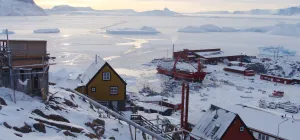The long journey home from the coast

Jos Van Hemelrijck recounts the journey home to the Princess Elisabeth station form the coast. On the way, the team gets to test out the new customised Toyota Hiluxes.
A long journey home
Now we’re back at the Princess Elisabeth station and glad to be here. Our bones are still a bit sore after a bumpy, 20-hour trip with no sleep. We were grateful for the hot showers and the soft pillows of the station! Princess Elisabeth feels very much like “home” to us after spending four days on the ice.
The return trip from the coast went well. One of the Prinoth tractors had to be repaired along the way. Fibrous debris had partially blocked its fuel lines. But it was no big deal for our seasoned mechanics. Kristof had the snow tractor back in service and running within 20 minutes.
Two of the Lehman sledges in the convoy were loaded with wooden beams and long rafters that will be used for finishing the new garages. They were very heavy - 12 tons per sledge - and oversized on top of that. The overhanging beams made it impossible to hook the sledge up to the preceding one (the pulling ring normally locks onto a hook). Instead, these sledges had to be dragged with a long rope at the end of the train.
Ilir and David drove the Prinoth with the heaviest load. On two different occasions when going up a steep slope, their train got bogged down in the snow. The tracks of their tractor were digging deeper and deeper, unable to get any traction on the snow. Kristof, who was bringing up the rear, had to unhook his Prinoth to come to the rescue and drag them up the hill.
Testing out the Hiluxes
The two Toyota Hiluxes - our new toys - had no trouble at all driving up the hills at full clip. They were able to maintain speeds of 40 kilometres an hour and more, even over rough patches of snow. If you compare that to the usual 10 to 12 kilometres an hour the Prinoths can do, it’s easy to understand that these vehicles will make a big difference on future field trips.
It is odd, however, to see four triangular tracks on a vehicle you would expect to find on the roads back home. They’ve been fitted with all sorts of amenities like a hi-fi stereo and so on. The warning beeps if you forgot to put on your safety belt – including the passengers’ - was bit of a nuisance. We’ll get rid of that I’m sure.
One thing that surprised me was the fuel consumption of these vehicles in Antarctica. A conventional 4 x 4 would need 11 or 12 litres per 100 kilometres on the road back home. I expected the track-fitted Hiluxes would use more fuel in an Antarctica environment. Driving in these Antarctic conditions cannot be compared to anything back home. But I was surprised to learn that we emptied the fuel tank of one of the Hiluxes before reaching the station, after a mere 200 kilometres!
Kristof Soete, who converted the Hiluxes, assured me that some fine tuning will improve fuel efficiency. “When you consider that even a one-man snow mobile uses 20 litres for every 100 kilometres and a Prinoth needs 50 litres of jet fuel to cover 12 kilometres in an hour," explained Kristof, "you realise that these Hiluxes are really a great asset for our transport needs.”
It's good to be back!
At the station we were welcomed by our six friends who stayed at PEA during our four days of absence. Carpenters Jacques Touchette and Chick Blaise were more than happy to see the long-awaited beams they needed to continue building the garages - and to have some company again. While we were gone, there were only six people at the station - which made it seem quite empty following the departure of the German scientists.
We learned that during our absence, Chick had broken a bone in his hand when he slipped on an icy spot in the garage. Doctor Richon had to fit him with a plaster cast, but he was back on the job. “No problem!” he said. “It’s my left hand. I’m right-handed anyway.”
Before we went to bed, we all joined the cooks David and Riet to transfer all the food we brought to the station’s fridge and freezer. We marvelled at the fresh eggs (imagine, we can have an omelette again!) mangos, grapes, frozen fillets of steak and fish. We even noticed a box of foie gras. But that, we heard, was for next years’ Christmas dinner. These supplies must last until the arrival of the next ship - in January next year, hopefully.
Download





















